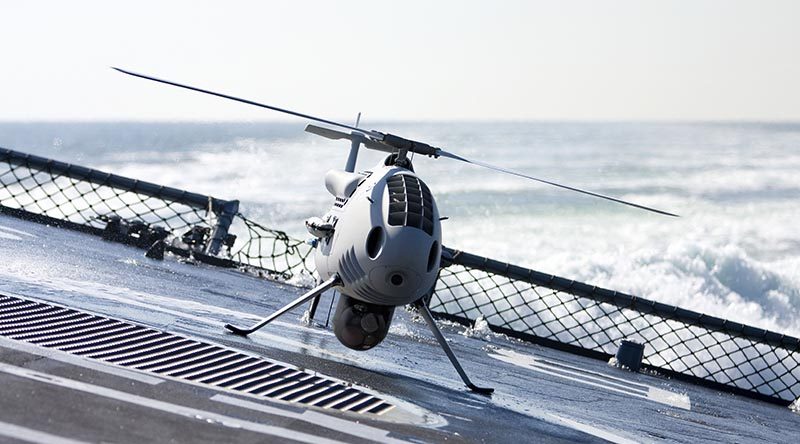Australian Navy buys CAMCOPTER® S-100

The Royal Australian Navy has awarded a contract to Schiebel to fulfil its desire to own and operate an unmanned aerial reconnaissance/surveillance system.
Schiebel’s CAMCOPTER® S-100 UAS was selected as that system – with the contract also including three years of follow-on contractor logistics support.
CAPTION: A CAMCOPTER® S-100 operated by the German Navy. Photo supplied by Schiebel.
Navy released an international Request for Tender (RfT) in February last year for a UAS capability.
Following thorough proposal evaluation and negotiations, the contract was signed with Austrian tech company Schiebel at the end of December.
This was largely a paperwork exercise, however, because the Navy had already comprehensively tested and evaluated the S100, giving it a glowing report card in Navy Newspaper in July 2015. Insitu’s Integrator fixed-wing platform was also evaluated, but wasn’t reported on in Navy Newspaper.
Hans Georg Schiebel, owner of Schiebel Group, said, “We feel most honored by the Royal Australian Navy’s decision to purchase our CAMCOPTER® S-100 UAS”.
“We are sure that the S-100 will prove to be an effective asset that will set a new benchmark for UAS capability,” Mr Schiebel.
“As the experience our company’s diverse maritime customers shows, the CAMCOPTER® S-100 improves the situational awareness of ship-borne operations substantially, making it the number one short-range tactical unmanned aircraft for naval applications.
“The CAMCOPTER® S-100 holds an impressive track record of supporting naval customers, with missions successfully completed on over 30 different ships on all the world’s oceans, in every environment from the tropics to the Arctic.”
Schiebel’s CAMCOPTER® S-100 Unmanned Air System (UAS) is a proven capability for military and civilian applications.
The vertical takeoff and landing (VTOL) UAS needs no prepared area or supporting launch or recovery equipment.
It operates in day and night, under adverse weather conditions, with a beyond line-of-sight capability out to 200km, on land and at sea.
In its standard configuration, the S-100 can carry a 34kg payload for up to 10 hours, powered with AVGas or heavy fuel.
The S-100 navigates via pre-programmed GPS waypoints or is operated with a pilot control unit.
Missions are planned and controlled via a simple point-and-click graphical user interface.
High definition payload imagery is transmitted to the control station in real time.
Using ‘fly-by-wire’ technology controlled by a flight computer, the UAV can complete its mission automatically.
Its carbon-fiber and titanium fuselage provides capacity for a wide range of payload/endurance combinations up to a service ceiling of 18,000ft.
UPDATE: From Navy Daily (official online publication) – 13 February 2017:
The next phase of introducing an unmanned aircraft system capability to the Royal Australian Navy has progressed.
Contracts have been signed with Austrian company, Schiebel Aircraft GmbH, to deliver Navy Minor Project 1942.
The maritime rotary wing unmanned aircraft system is being acquired to support trials and evaluation activities for at least the next three years.
The contract comprises two S100 Camcopter air-vehicles with mission control systems, as well as engineering, logistics and operational support.
The Navy is rapidly developing an enduring unmanned aircraft system capability that will improve the situational awareness for ships, providing a significant warfighting advantage.
Unmanned systems will be critical in future warfighting and will allow ships to more readily see beyond the horizon, providing greater intelligence, surveillance and reconnaissance capabilities.
The project is another step towards ensuring that the Australian Navy remains at the forefront of maritime aviation technology.
The $16 million project will build on the knowledge and experience already gained through operating the fixed wing ScanEagle unmanned system, and enables the Navy to further define Australian requirements for operating tactical unmanned systems in the maritime environment.
The project will give Navy an understanding of the workforce requirements, organisational structures, performance specifications, tactics and procedures required to maintain a permanent unmanned capability.
As tactical unmanned aerial systems are emerging technologies, particularly vertical take-off and landing systems from ships at sea, Navy has adopted an innovative phased ‘learn by doing’ approach.
Navy is comprehensively testing a variety of new systems to reduce risks ahead of acquiring a permanent unmanned capability in the early 2020s, that will see the capability embarked in the future fleet.
The in-country support for the system is being provided by BAE Systems in Nowra and Unmanned Systems Australia in Brisbane.
.
.
.
.
.
.
.
.

.
.






